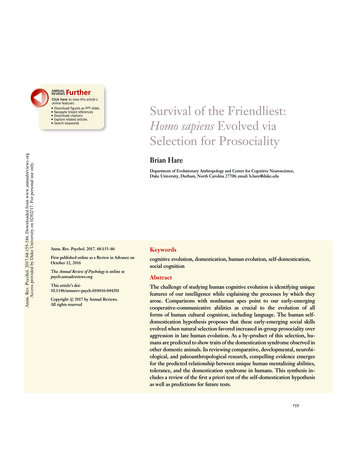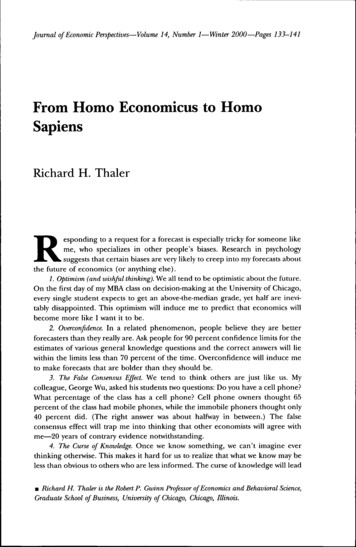
Transcription
PS68CH07-HareARIANNUALREVIEWS17 November 201612:56FurtherAnnu. Rev. Psychol. 2017.68:155-186. Downloaded from www.annualreviews.orgAccess provided by Duke University on 02/02/17. For personal use only.Click here to view this article'sonline features: Download figures as PPT slides Navigate linked references Download citations Explore related articles Search keywordsSurvival of the Friendliest:Homo sapiens Evolved viaSelection for ProsocialityBrian HareDepartment of Evolutionary Anthropology and Center for Cognitive Neuroscience,Duke University, Durham, North Carolina 27708; email: b.hare@duke.eduAnnu. Rev. Psychol. 2017. 68:155–86KeywordsFirst published online as a Review in Advance onOctober 12, 2016cognitive evolution, domestication, human evolution, self-domestication,social cognitionThe Annual Review of Psychology is online atpsych.annualreviews.orgThis article’s doi:10.1146/annurev-psych-010416-044201c 2017 by Annual Reviews.Copyright All rights reservedAbstractThe challenge of studying human cognitive evolution is identifying uniquefeatures of our intelligence while explaining the processes by which theyarose. Comparisons with nonhuman apes point to our early-emergingcooperative-communicative abilities as crucial to the evolution of allforms of human cultural cognition, including language. The human selfdomestication hypothesis proposes that these early-emerging social skillsevolved when natural selection favored increased in-group prosociality overaggression in late human evolution. As a by-product of this selection, humans are predicted to show traits of the domestication syndrome observed inother domestic animals. In reviewing comparative, developmental, neurobiological, and paleoanthropological research, compelling evidence emergesfor the predicted relationship between unique human mentalizing abilities,tolerance, and the domestication syndrome in humans. This synthesis includes a review of the first a priori test of the self-domestication hypothesisas well as predictions for future tests.155
PS68CH07-HareARI17 November 201612:56ContentsAnnu. Rev. Psychol. 2017.68:155-186. Downloaded from www.annualreviews.orgAccess provided by Duke University on 02/02/17. For personal use only.INTRODUCTION . . . . . . . . . . . . . . . . . . . . . . . . . . . . . . . . . . . . . . . . . . . . . . . . . . . . . . . . . . . . . . .PAN VERSUS HOMO SOCIAL UNDERSTANDING . . . . . . . . . . . . . . . . . . . . . . . . . . . .Apes Take Others’ Perspectives and Cooperate Flexibly . . . . . . . . . . . . . . . . . . . . . . . . . .Only Human Apes Cooperatively Communicate . . . . . . . . . . . . . . . . . . . . . . . . . . . . . . . . .THE DOMESTICATION OF DOG SOCIAL COGNITION . . . . . . . . . . . . . . . . . . . . .Dogs Are Wolves Prepared to Cooperatively Communicate . . . . . . . . . . . . . . . . . . . . . .Foxes Selected for Friendliness Cooperatively Communicate . . . . . . . . . . . . . . . . . . . . . .Dog Self-Domestication . . . . . . . . . . . . . . . . . . . . . . . . . . . . . . . . . . . . . . . . . . . . . . . . . . . . . . . .BONOBO SELF-DOMESTICATION . . . . . . . . . . . . . . . . . . . . . . . . . . . . . . . . . . . . . . . . . . . .Sexual Selection of Friendlier Male Apes . . . . . . . . . . . . . . . . . . . . . . . . . . . . . . . . . . . . . . . . .A Priori Tests of Bonobo Self-Domestication . . . . . . . . . . . . . . . . . . . . . . . . . . . . . . . . . . . .THE INFLUENCE OF HUMAN TEMPERAMENT ON MENTALIZING . . . . . .THE HUMAN SELF-DOMESTICATION HYPOTHESIS . . . . . . . . . . . . . . . . . . . . . . .The First A Priori Test of Human Self-Domestication . . . . . . . . . . . . . . . . . . . . . . . . . . .The Eye of Cooperative Communication . . . . . . . . . . . . . . . . . . . . . . . . . . . . . . . . . . . . . . . .Like-Me Psychology Drove Paleolithic Self-Domestication . . . . . . . . . . . . . . . . . . . . . . .Self-Control: The Unique Feature of Human Self-Domestication . . . . . . . . . . . . . . . . .Self-Domestication Through Evolutionary Development . . . . . . . . . . . . . . . . . . . . . . . . .CONCLUSION . . . . . . . . . . . . . . . . . . . . . . . . . . . . . . . . . . . . . . . . . . . . . . . . . . . . . . . . . . . . . . . . . 72173175“Man in many respects may be compared with those animals which have long been domesticated.”—Charles Darwin (1871)INTRODUCTIONDarwin viewed the evolution of human intelligence and morality as the greatest challenge forhis theory of evolution through natural selection (Darwin 1871). This remains the case today(MacLean et al. 2012). Our language and cultural cognition allows for cooperation and technologymore complex than anything seen in nonhumans, yet our neurobiology, psychology, and genomeare remarkably similar to other apes (Somel et al. 2013). A complete theory of human cognitiveevolution needs to explain how these shared traits evolved into new forms of human cognition. Tomeet Darwin’s challenge, we must identify derived cognitive features that evolved in our lineageand support our unique phenotype. Then we must identify the process by which these traits arose(Hare 2007, 2011). Adding to this challenge are discoveries suggesting that at least 10 differentspecies evolved within the genus Homo. Modern theories of human cognitive evolution must nowcontend with growing evidence that Homo sapiens is just one among many human species thatevolved. It is no longer enough to point out what makes us human. We must also determine whatallowed our species to outlast as many as five other large-brained human species that shared theplanet with us, some perhaps until as recently as 27 kya (Wood & Boyle 2016).This article reviews the latest research suggesting that early-emerging cooperativecommunicative skills are responsible for unique features of human cognition and that ourpsychology evolved in large part due to selection for prosociality (i.e., positive but potentiallyselfishly motivated acts as opposed to antisocial interactions; Eisenberg et al. 1983). Comparisonsof mentalizing skills between apes reveal that among apes, only human infants develop cooperativecommunicative skills that facilitate human forms of cultural cognition; however, domestic dogskya: thousands ofyears ago156Hare
Annu. Rev. Psychol. 2017.68:155-186. Downloaded from www.annualreviews.orgAccess provided by Duke University on 02/02/17. For personal use only.PS68CH07-HareARI17 November 201612:56possess some social skills that resemble those seen in human infants. Research with experimentallydomesticated foxes and bonobos shows how selection for prosociality can lead to increases in thecooperative-communicative flexibility observed in dogs and infants. This comparative developmental work provides the basis for the self-domestication hypothesis, which proposes that uniquehuman psychology evolved as part of a larger domestication syndrome that converges with otherdomesticated animals.The human self-domestication hypothesis (HSD) draws on comparative, developmental, fossil,and neurobiological evidence to show that late human evolution was dominated by selection forintragroup prosociality over aggression. As a result, modern humans possess traits consistentwith the syndrome associated with domestication in other animals (Table 1). The HSD suggeststhis selective pressure also led to enhanced cooperation in intergroup conflicts. The hypothesisproposes that the reduced emotional reactivity that results from self-domestication and increasedself-control created a unique form of human tolerance allowing the expression of more flexiblesocial skills only observed in modern humans. Expanded developmental windows like those seen indomesticated animals allow this unique form of human tolerance and social cognition to developand left H. sapiens as the last human standing (Figure 1).HSD: humanself-domesticationhypothesisPAN VERSUS HOMO SOCIAL UNDERSTANDINGOur ability to mentalize, or attribute mental states to others, is the foundation of cultural cognition(Herrmann et al. 2007). Humans develop the ability to recognize what others perceive, feel, intend,and know. Children begin in infancy to recognize that others can have mental states and even falsebeliefs that can differ from their own or reality. As adults, we rely on our ability to infer others’unobservable thoughts based on observable social cues and context. Our ability to reason about theminds of others allows for everything from imitation to deception, group coordination, teaching,and language acquisition (Seyfarth & Cheney 2014, Tomasello 2009b). Given the central role ofthese skills in human social cognition, tremendous energy has been focused on testing whetherthey are shared with other animals or are a derived feature of human cognition (Hare 2011).Apes Take Others’ Perspectives and Cooperate FlexiblyBeginning in the 1970s, chimpanzees (Pan troglodytes) quickly became central to studies of mentalattribution because they provided a powerful phylogenetic test. The skills we share with chimpanzees were probably present in our last common ancestor, but the skills found only in humanshelp explain our explosive evolutionary success.Initial research on chimpanzee theory of mind was as methodologically flawed as it was pioneering. It was only after researchers began taking an ecological approach to cognition that majoradvances were made in our understanding of chimpanzee mentalizing (Hare 2001, Whiten 2013).Chimpanzees failed to solve visual perspective-taking problems by cooperating and communicating with humans. However, they solved similar problems when placed in competition againsteach other. A series of competitive experiments show that chimpanzees are skilled at taking theperspective of others based on their current and previous perceptual experience (Hare 2011).This led to more powerful methods using larger samples that also showed these skills in noncompetitive contexts (MacLean & Hare 2012). These spontaneous measures of social cognitionruled out the potential for simple behavior reading or learning within the experiment (Hare 2011;although see Povinelli & Vonk 2004).Several studies have suggested that chimpanzees understand what others know, but there remains no compelling evidence for explicit false belief understanding in any animal, including greatwww.annualreviews.org Only the Friendliest Human Species Survived157
PS68CH07-HareARITable 117 November 201612:56Evidence for domestication syndrome in modern humansAnnu. Rev. Psychol. 2017.68:155-186. Downloaded from www.annualreviews.orgAccess provided by Duke University on 02/02/17. For personal use only.Dog versus wolf aExperimental foxversus control foxaBonobo versuschimpanzeeaHolocene humans versusLower Paleolithic humansAggressionLower-intensityinter- andintragroupaggression in feraldogsExperimental butnot control foxesare nonaggressivetoward humansLower intensity inter- andintragroup aggression inbonobosIntragroup tolerance allows andis favored due to demographicpressure in Holocene humans(Cieri et al. 2014, Henrich 2015)PhysiologyDogs show a mutedstress responsewhen interactingwith humansHigher basalserotonin and lowercorticosteroids inexperimental foxesBonobos have more apassive coping responseto social stressHolocene humans exhibitmorphologically inferredreductions in neonatalandrogens and pubertaltestosterone levels and increasedbrain serotonin and oxytocinavailability (Cieri et al. 2014,Nelson et al. 2011)MorphologyDogs show reducedcranial capacity anddepigmentation ofthe coatExperimental foxesshow a feminizedskull anddepigmentation ofthe coatBonobos show reducedcranial capacity,feminized faces, anddepigmentation of lipsand tail tuftsHolocene humans exhibit amodest reduction in cranialcapacity, feminized faces,globular cranial development,and depigmentation of the sclera(Cieri et al. 2014, Hublin et al.2015, Tomasello et al. 2007)ProsocialbehaviorDogs are moreattracted to humansthan to conspecificsExperimental foxesare more attractedto and interested inplaying andinteracting withhumans as adultsBonobos exhibit more playand sociosexual behavioras adults, voluntarilyshare food, and are morefood tolerantHolocene humans exhibitextreme levels of intragroupfood sharing, helping, and socialbonding (Kramer 2014,Warneken 2015)ExpandeddevelopmentalwindowPeriod ofsocialization withhumans beginsearlier and lastslonger in dogs; dogsretain the juvenilevocal repertoireinto adulthoodPeriod ofsocialization withhumans beginsearlier and lastslonger inexperimental foxes;experimental foxesretain the juvenilevocal repertoireinto adulthoodNonreproductivesociosexual behaviorsthat create toleranceemerge early and lastthroughout adulthood inbonobos; cognitive skillsrelated to spatial memoryand social inhibitionexhibit delayeddevelopment in bonobosHolocene humans exhibitearly-emerging social cognitionand graded brain developmentwith extreme delays in synapticpruning of cortical regions(Casey & Caudle 2013, Somelet al. 2009, Wobber et al. 2014)Social cognitionDogs are moresensitive to humansocial cuesExperimental foxesare more sensitiveto human socialcuesBonobos attend to eyesand exploit a human’sgaze more and showincreased cooperativeflexibilityHolocene humans exhibitincreases in cooperativecommunication, culturalratcheting, and coordinateddefense against out-groups, aswell as expanded social networks(Cieri et al. 2014, Hare 2011)aNonhuman comparisons are based on Hare et al. (2012)158Hare
PS68CH07-HareARI6 December 201618:58Annu. Rev. Psychol. 2017.68:155-186. Downloaded from www.annualreviews.orgAccess provided by Duke University on 02/02/17. For personal use only.Human self-domesticationIncreased tolerance and prosocialityIncreased serotonin and oxytocinExpanded developmental windowsFeminized or juvenilized morphologyIncreased cooperative communicationFigure 1Homo sapiens evolved, in part, as a result of selection for increased in-group prosociality during thePaleolithic, leading to a variety of morphological, physiological, and cognitive changes also observed indomestic animals such as Canis familiaris.apes (Hare 2011, Martin & Santos 2016). Further studies have shown that, in many contexts, chimpanzees behave similarly to human children when they attribute intentions to others. For example,chimpanzees are more patient with an experimenter who is unable to share food than with onewho is clearly unwilling (Call et al. 2004).These social cognitive skills are also applied flexibly to a number of cooperative situations.Chimpanzees can solve novel instrumental problems that require cooperation and helping (Hare& Tan 2012, Melis et al. 2010). They know when they need to recruit help, which potential helperis most skilled, and what leverage they have to negotiate between equal and unequal payoffs (Meliset al. 2006a, 2008, 2009). Chimpanzees are also capable of taking different roles in collaborativetasks (Melis & Tomasello 2013).www.annualreviews.org Only the Friendliest Human Species Survived159
PS68CH07-HareARI17 November 201612:56Taken together, chimpanzees are flexible in assessing what others perceive and intend. Although chimpanzees are skilled cooperators and take other’s perspectives in noncompetitive contexts, it was initially easier to demonstrate many of their theory of mind skills in competitive tasks(Hare 2011).Only Human Apes Cooperatively CommunicateAnnu. Rev. Psychol. 2017.68:155-186. Downloaded from www.annualreviews.orgAccess provided by Duke University on 02/02/17. For personal use only.Despite the social flexibility of chimpanzees, there are meaningful gaps in their understandingof and tolerance for others. Several studies show that, although chimpanzees can cooperate orcommunicate, they struggle to do both (Bullinger et al. 2014, Herrmann & Tomasello 2006,Melis et al. 2009). Central to this phenomenon is their inability to spontaneously and flexiblyuse gestures to find hidden food (Hare 2011). Human infants begin using other’s gestures andproducing them in their first year of life. Infants become part of the cultural world of adults bydeveloping an understanding of the intention behind novel and arbitrary gestures. In contrast,while nonhuman apes can slowly learn to use cooperative-communicative gestures, it is extremelydifficult for them to generalize what they learn to a new or arbitrary gestural signal (Call et al. 1998,Hare & Tomasello 2005b, Herrmann et al. 2007, MacLean & Hare 2015a; although see De Waalet al. 2008). This limitation is made worse by the inability of chimpanzees to remain tolerantduring cooperative activities. Although chimpanzees are skilled at using other chimpanzees associal tools, cooperation breaks down when the reward for joint effort becomes easily monopolized(MacLean & Hare 2013). Chimpanzees are constrained in their ability to inhibit intolerance towardpotential cooperative partners even when they know they cannot solve a problem alone. Only asmall minority of chimpanzee dyads within a group are tolerant enough to work for sharable foodand no dyad can cooperate once rewards require active sharing or turn taking (Hare et al. 2007,Melis et al. 2006b). This intolerance and inflexibility in cooperative-communicative contexts likelyprevent chimpanzees from sharing intentions and building on previous innovations in a processknown as cultural ratcheting (Hare 2011).THE DOMESTICATION OF DOG SOCIAL COGNITIONDomestic dogs are more skillful at using human gestures than nonhuman apes (Hare et al. 2002).Dogs follow the direction of a human gaze or point to locate hidden food or toys. If a humanpoints to one of two locations, dogs are more likely to search where a human has indicated. Dogscan even spontaneously use novel and arbitrary gestures to help direct their search for objects orfood. Several controls rule out the possibility that these searches in response to human gesturesare reflexive or based on olfactory cues (Hare & Tomasello 2005b). Another similarity betweendogs and infants is that both commit the A not B search error when directed by a human in theclassic Piagetian task. Like human children in this task, dogs search in a hiding location that hasrepeatedly been baited in the past over a new location they observe being baited (Topál et al. 2009).Dogs are also the only nonhumans capable of fast mapping. In a way similar to the way youngchildren learn words, several border collies have acquired hundreds of object labels using theprinciple of exclusion after single interactions with each new toy (Kaminski et al. 2004). Dogs seemto understand the cooperative-communicative intent of human signals in ways resembling thoseof the youngest human infants. This raises the question of how such a distantly related species canshow skills that are crucial to human social cognitive development (Kaminski & Marshall-Pescini2014). Comparisons of canids have revealed an important process by which social cognitionevolves.160Hare
PS68CH07-HareARI17 November 201612:56Dogs Are Wolves Prepared to Cooperatively CommunicateAnnu. Rev. Psychol. 2017.68:155-186. Downloaded from www.annualreviews.orgAccess provided by Duke University on 02/02/17. For personal use only.Dogs do not need intensive exposure to humans to begin using our gestures. Dog puppies also showskill at using basic human gestures (Hare et al. 2002). Although variance exists among individualdogs, as a species, dogs rely on human gestures even as puppies (Hare et al. 2010, Stewart et al.2015, Wobber et al. 2009). Dogs did not inherit this early-emerging pattern from wolves. Theskills of wolves at reading human gestures are more similar to those of nonhuman apes thanto those of dogs. To develop skills in reading human gestures, wolves require intensive humansocialization during a short critical period; as the window of socialization closes, they show littleskill at understanding humans without explicit training as adults (Gacsi et al. 2005, Hare et al.2002, Viranyi et al. 2008). Unlike dogs and infants, wolves do not commit the socially mediated Anot B error (Topál et al. 2009). The independence of wolves from humans also means that whenfaced with an impossible task, they continue to try to solve the problem without help, whereasdogs quickly look to a human for help (Miklósi et al. 2003).Foxes Selected for Friendliness Cooperatively CommunicateBecause the early-emerging skill at reading gestures is not observed in wolves, the unusual socialskills of dogs probably appeared during domestication (Hare et al. 2010). This hypothesis wastested by examining the cooperative-communicative abilities of an experimental line of foxesthat had been intensively selected to be attracted to and nonaggressive toward people for 45generations (Trut 1999). The experimental line was compared to a control line bred randomly forhow they respond to humans. As a result of this selection, the experimental line is highly prosocialtoward humans and exhibits a suite of phenotypic traits known as the domestication syndrome(Table 1). In comparison to the control line, the experimental foxes show the expected increasesin approach toward humans. However, they also show a high frequency of traits not intentionallyselected, including physiological, morphological, developmental, and behavioral changes also seenin domestic animals. This domestication syndrome includes increased brain serotonin levels andreductions in hypothalamic-pituitary-adrenal axis reactivity. Morphologically, the experimentalfoxes show increased frequencies of piebald coats, star mutations (white spots on the forehead),shorter muzzles, feminized faces, floppy ears, and curly or shortened tails (Trut et al. 2009).Developmentally, most traits in the experimental foxes appear to relate to expanded developmentalwindows. Experimenters can socialize experimental foxes earlier in development and the periodof socialization remains open for much longer (i.e., similar to that of dogs) (Belyaev et al. 1985).Adult experimental foxes use juvenilized vocalizations and social behaviors such as tail waggingfar more frequently when approached by humans than adult control foxes do (Gogoleva et al.2008). When tested on the same cognitive measures of cooperative-communication used withapes, dogs, and wolves, fox kits from the experimental line are more skilled than same-age controlkits. The experimental foxes spontaneously use basic human gestures in two different paradigmsand perform similarly to dog puppies of the same age. Controls demonstrate that the experimentaland control foxes are similarly motivated even though only the experimental line responded tohuman gestures. Although the experimental line was never selected (or even evaluated) on thebasis of their cooperative-communicative abilities with humans, experimental kits perform likedog puppies when responding to human gestures (Hare et al. 2005).The foxes’ performance with human gestures supports the hypothesis that dogs’ social skillsevolved not only during domestication but also as a result of it. The fox experiment demonstratesthat selection on emotional reactivity changes not only temperament but also a suite of unrelatedphenotypic traits as a correlated by-product of this selection. The more flexible skills of cooperatingand communicating with humans probably represent another of the by-products of this selectionwww.annualreviews.org Only the Friendliest Human Species Survived161
PS68CH07-HareARI17 November 201612:56for friendliness. Foxes, like most mammals, use the social cues of conspecifics, but due to selectionfor prosocial interactions with humans, these old cognitive skills are applied in a new interactionwith a new social partner (Hare & Tomasello 2005a).Less reactive temperament likely replaced fear with an attraction to humans as selection actedon developmental pathways. Shifts in development, especially early in fetal development, can alteremotional reactivity and are thought to create a cascade of unselected consequences throughoutthe phenotype (Price & Langen 1992, West-Eberhard 2003, Wilkins et al. 2014). For example,the neural crest hypothesis suggests that the domestication syndrome is a result of changes inthe migration pattern of melanocytes during neural crest formation, which simultaneously affectsneurohormone levels, pigmentation, and morphology early in development (Wilkins et al. 2014),although not in a universal pattern across domestic mammals (Sanchez-Villagra et al. 2016).Annu. Rev. Psychol. 2017.68:155-186. Downloaded from www.annualreviews.orgAccess provided by Duke University on 02/02/17. For personal use only.Dog Self-DomesticationBased on the fox findings, it might be that dog cognition also evolved as a by-product of selectionon emotional reactivity. However, in the case of dog evolution, natural selection acted on thetemperament of wolves. Wolves with a temperament allowing them to approach human settlements showed higher reproductive success and favored self-domestication (as do species adaptingto urban environments today; Ditchkoff et al. 2006). A population of wolves able to exploit thenew niche of scavenging food remains and feces became more tolerant of humans and could bediscriminated from other wolves due to morphological traits associated with the domesticationsyndrome. This new interaction with humans allowed old cognitive abilities to be expressed ina new context and resulted in more flexible social problem solving with humans. As the constraint of temperament was lifted, heritable variance in these newly revealed social skills may havebeen targeted by selection (Wobber et al. 2009). Thus began the most successful interspecificcooperative-communicative relationship in mammalian evolutionary history (Hare et al. 2010,Hare & Woods 2013; although see Udell et al. 2010). This led to a bond so strong that exogenousadministration of oxytocin in dogs also modulates increases in mutual gaze, physical contact, andendogenous oxytocin expression in the humans with which they interact (Nagasawa et al. 2015).Not only have the emotional systems of dogs evolved but they have also hijacked our emotionalsystems for at least 15,000 years (MacLean & Hare 2015b).BONOBO SELF-DOMESTICATIONThe experimental foxes and dog self-domestication both imply that natural selection can lead toincreases in prosocial over aggressive behavior, which can in turn lead to domestication syndrome(Table 1). The self-domestication hypothesis predicts that natural selection would also haveshaped other species for increases in prosociality. Bonobos (Pan paniscus), one of our two closestliving relatives, have been identified as a likely candidate for self-domestication (Wrangham &Pilbeam 2002).Sexual Selection of Friendlier Male ApesBonobos differ from chimpanzees in their aggressive behavior (Hare et al. 2012). No bonobo hasever been observed to kill another bonobo (although for a potential exception see Wilson et al.2014). Unlike chimpanzees, male bonobos do not coerce females, commit infanticide, or targettheir own mothers for aggression. Also unlike chimpanzees, male bonobos do not form coalitionswith one another within their groups but instead rely on their mother’s status to gain access to162Hare
PS68CH07-HareARI17 November 201612:56Annu. Rev. Psychol. 2017.68:155-186. Downloaded from www.annualreviews.orgAccess provided by Duke University on 02/02/17. For personal use only.females (Surbeck et al. 2011). Finally, unlike chimpanzees, male bonobos do not participate inborder patrols or lethal raids into neighboring territories.Hare et al. (2012) proposed that male bonobos evolved to be more prosocial through sexualselection. Living in a richer and more predictable ecology, unrelated female bonobos formedbonds that allowed them to respond to male aggression in a way that female chimpanzees cannot.Although wild female chimpanzees rarely support other females when they are targeted by aggressive males, similar coercion by male bonobos is met by female coalitionary defense (Tokuyama &Furuichi 2016). Similarly, female bonobos do not tolerate male aggression toward juveniles andinfants (Hare & Yamamoto 2015, Walker & Hare 2016). According to the self-domestication hypothesis, bonobos evolved to be less aggressive because females were able to express a preferencefor less aggressive males.A Priori Tests of Bonobo Self-DomesticationAfter Wrangham & Pilbeam (2002) initially proposed that bonobos could be a candidate forself-domestication, a number of a priori tests examined whether derived features of the bonobophenotype fit the expected pattern of domestication syndrome (Table 1).Hare et al. (2012) reviewed the evidence that differences between bonobo and chimpanzee prosocial behavior, physiology, morphology, development, and cognition support selfdomestication. Bonobos are more tolerant than chimpanzees when sharing food because bonobosuse sex and play to reduce social tension when conflicts arise (Hare et al. 2007; although see Jaeggiet al. 2010). Bonobos also voluntarily share food. When given the choice of either eating preferredfood before their morning meal or opening a one-way door to allow another bonobo to share thefood, bonobos prefer to eat together. When bonobos can choose to open a door for either a groupmember or a stranger, they prefer to share with another bonobo with which they have neverphysically interacted (Tan & Hare 2013). This level of xenophilia contrasts with the xenophobiathat chimpanzees show toward strangers (Wilson et al. 2014).The unusual sharing observed in bonobos is modulated by their physiological response to socialstress. Before a dyad of male bonobos is released into a room with food, they show increases incortisol, associated with a stress response, but not testosterone, typically associated with agonism.The increase of cortisol in male bonobos promotes tolerance by creating a passive coping stylethat encourages social cont
Homo sapiens Evolved via Selection for Prosociality Brian Hare Department of Evolutionary Anthropology and Center for Cognitive Neuroscience, Duke University, Durham, North Carolina 27708; email: b.hare@duke.edu Annu. Rev. Psychol. 2017. 68:155–86 First published online as a Revie











